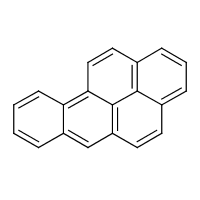Benzo(a)pyrene
Agent Name
Benzo(a)pyrene
CAS Number
50-32-8
Formula
C20-H12
Major Category
Other Classes

Synonyms
1,2-Benzpyrene; 3,4-BP; 3,4-Benz(a)pyrene; 3,4-Benzo(a)pyrene; 3,4-Benzopirene [Italian]; 3,4-Benzopyrene; 3,4-Benzpyren [German]; 3,4-Benzpyrene; 4,5-Benzpyrene; 6,7-Benzopyrene; B(a)P; BP; BaP; Benz(a)pyrene; Benzo(d,e,f)chrysene; [ChemIDplus]
Category
Polycyclic Aromatic Hydrocarbons
Description
Yellowish solid; Practically insoluble in water; [Merck Index] Yellow crystals; Insoluble in water; [MSDSonline]
Sources/Uses
Used as a research chemical; Not commercially used in the US; [HSDB] Formed during incomplete combustion of organic compounds; Highest levels in aluminum production (up to 100 ug/m3), then roofing and paving (10-20 ug/m3), then lowest exposures: coal liquefaction, coal-tar distillation, wood treatment with creosote, chimney sweeping, and power plants; [Reference #1]
Comments
Benzo(a)pyrene is a biomarker of polycyclic aromatic hydrocarbon (PAH) exposure as occurs in aluminum production and coal gasification, two processes which are carcinogenic to humans (urinary bladder and lung). Exposure to soot in chimney sweeping is a known human carcinogen; Other occupational exposures to PAHs classified as Group 1 are coke production, coal-tar distillation, paving and roofing with coal-tar pitch. [Reference #1] Reason for exclusion from occupational carcinogens: "Group 1 classification based on mechanistic upgrade." [PMID 29769352] See "POLYCYCLIC AROMATIC HYDROCARBONS." See "Soots," "Coal tar pitch volatiles," "Coke oven emissions," and "Shale oils."
Reference Link #1
Biomedical References
Exposure Assessment
BEI
1-Hydroxypyrene (1-HP) in urine = 2.5 ug/L at end of shift at end of workweek; (Adjusted for the Pyrene to Benzo(a)pyrene ratio); 3-Hydroxybenzo(a)pyrene (3-HBAP) in urine = Nq at end of shift at end of workweek; [TLVs and BEIs]
PEL (OSHA)
0.2 mg/m3
Vapor Pressure
5.49E-09 mm Hg
Explanatory Notes
"Germ cell mutagens that have shown to increase the mutant frequency in the progeny of exposed mammals." [MAK]
Adverse Effects
Reproductive Toxin
Yes
IARC Carcinogen
Established
NTP Carcinogen
Anticipated human carcinogen
ACGIH Carcinogen
Suspected Human
Diseases, Processes, and Activities Linked to This Agent
Processes
Activities
Activities with risk of exposure: